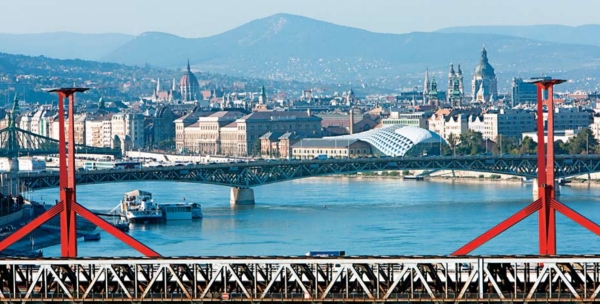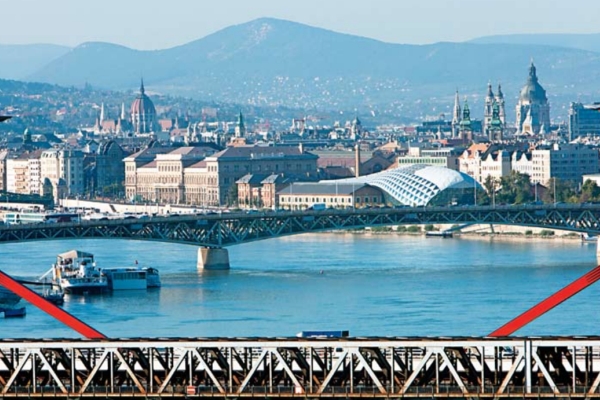The Whale on the Bank of River Danube
Non-Standard Review
Architects: Kas Oosterhuis, Ilona Lénárt
Text: Tamás Perényi
Photos: Tamás Bujnovszky

This October Marc Augé French ethnologist visited Budapest to deliver a lecture during the conference titled Science and Power after which he took part in discussions. One of the focuses of his research work in ethnology and anthropology is the interpretation of location. His stay here had nothing to do with the opening of the Whale in November which is a new public building of Budapest.
*
Augé’s name is usually mentioned apropos of the so-called „no-location” concept, and his study has been available in Hungarian for a year now. The expression „no-location” is only interpretable as an opposition: that of the traditional anthropological location. The genuine location features identity and historic authenticity, and „from that moment on it could be regarded a location necessarily when it acquires the minimum of stability by the union of identity and correlations”. Augé’s hypothesis that the modern age (he refers to it as surmodernité) creates locations that do not imply identity, relations and historicality either. These places are not locations in the anthropological sense and thus the definition of non-location is not obvious. Typical examples of non-locations are areas of transport and transit, shopping centres and temporary accommodations. Non-locations are not only abstract conditions, but also define the temporary identity of human beings living in them. According to Augé, this anonimity is experienced by people as a temporary liberation. No-location ambitions to establish a relationship with history, in which it only succeeds as a simple spectacle like references. Non-locations do not sharply separate from traditional places but intertwine with them as a necessary symbiosis. Augé argues that the reason for their simultaneous existence is politics, and he says politicians refer to the increasing number of non-locations continuously delaying „and only ponder on where to go on because in reality they less and less know where they actually are.”
*
I am standing on the Danube bank in Pest in front of the Whale and am looking at the central building of the University of Technology. The birth of the house is a clear and logical process. Financial and political conditions were similar to those of today, but Wlassits as minister held a firm view and the financial proposal of the government as well as the approval of the Parliament and the king defined exact limits. People contributing to the realisation are known and recognized people, the purposes of the participating institutions and the functional programme of the building was obvious. The house has served the continuously changing needs of education ever since.
I am standing on the Danube bank in Buda in front of the University of Technology now and am looking at the new building on the other side: the Whale. The capital wished to utilise an area which was highly precious. Lacking the necessary financials, a tender for private investors was published. As a programme it needed undefined mix-use cultural and commercial development. The winner of the contest was an offshore company earlier unknown with minimal capital.
The rest is only the consequence.
The functional consequence being that the northern entrance of the building was contained underground – by all means in order to maximize the utilisation of cellars – and only two smaller doors lead to the space beneath which gives people arriving here the impression of uncertainty.
An architectural consequence is contrary to the original plans and the concept of the designers (Kas Oosterhuis and Ilona Lénárt) removed from this project the plane of the glass shell was not lifted from the structure. Separation would have been necessary primarily for geometrical reasons: this was the only correct way to facilitate the connection of components of a surface curved twice. Being retracted, the glass panes could only be inlaid via thick takaróelemek which arrive at the discs in the junctions at random. However, the design of the ONL office was one of the main reasons for choosing the investor. Designers won international tenders because the structure they developed did not only offer innovative and versatile forms but also mature technical solutions and thus can be included in the budget as precisely calculated items.
Another consequence is the relation to the historic buildings, in this case also including storehouses. Built in 1881, stores designed by Lajos Krajcsovics also symbolised the role of Budapest as a commercial centre. To facilitate their creation „the audience of the capital made the greatest sacrifices”. The levels of the stores above the ground were connected with the vaulted cellars leading to the steam crane by the Danube by hydraulic levers. Of the four masonry stores only two were built in the new building whilst the third one was left unfinished and separate.
Stores standing on the area are protected historic monuments of Budapest only, and thus not national ones. A maximum of 40% demolition was thus allowed, which even exceeded this ratio when coming to structures above the ground as the majority of cellars survived. The long store building along the Danube bank fell victim to this, as an R-C superstructure was built above the cellar along enriched with façade facework imitating the old one and plaster cast ornaments. The integration of the stores in the new composition was out of necessity: the old buildings lost their identities, and the new house did not make use of what the industrial heritage offered and referred to.
(Extending the warehouses was an issue already at the turn of the last century. The large-scale market needed more and more space which was meant to be responded by roofing the area between the warehouses the project used. Samu Pecz, the architect commissioned with this task designed a glazed steel hall between the two buildings uniting the two independent structures into a three-nave one. The new structure did not change the exterior appearance of the store or their well-usable interiors, the realisation of which would have created a new quality.)
When opening it, the building was half empty, but this was only manageable by moving in some municipal institutions (e.g. the Budapest Gallery removed out of its downtown context).
*
Augé’s analysis fits the nicely curved steel structure like a thin skin. Similarly to live organisms, the fate of the Whale was also destined in the very moment of its birth.
*
Next to Plaza Major in Madrid there is a slender steel-structure glass-walled single-storey market called Mercado de San Miguel. Open from morning till midnight, it is a favourite place of tourists and locals as well. Small stalls sell stuffed olives, crabs, cheese, oysters, as well as hand-made chocolate and unique biscuits. Wines of the perfect temperature are poured into elegant glasses. There are no circulation areas between the counters but consumers’ places. Everyone is standing here turning to each other whilst talking. Refined elegance rules here, for which the architectural frame serves as a background.
The future of the Whale depends on this: whether we can find the functional harmony which makes this place genuinely humane. The faculties of the location, its orientation, access to the Danube, imposing interior offer an appropriate base. If it happens, the consequences mentioned before will turn insignificant, just like the challenges of the development, and the building shall be a new Venue of the capital.
Leading architects: Kas Oosterhuis, Ilona Lénárt – ONL Hungary Kft.
Statics: Péter Markovics – MTM Kft.
HVAC and electrical engineering: Gábor Szigyártó, György Pernyész, Attila Turi – SMG-SISU Kft.
Outdoor public utilities: Géza Hobl – Közműterv 2006 Kft.
Trarffic: Ádám Rohrer – Közlekedés Kft.
Garden design: Ildikó Szepezdi / Tér-Kert Kft.
Structure: Dr. László Kakasy
Fire protection: Dr. Lajos Takács
Acoustics: Róbert Csott
Realization plans of the original parts: László Szász, Csaba Lengyel – STÚDIÓ’100 Kft.
Realization plans of non-standard glass roof: Bernard Ötsch – AFC GmbH
Realization plans of non-standard steel framework: Csaba Kovács, Anna Nagy / Reticolo Kft.
Architect for coordinating the realization of steel-glass roof: Lajos Hartvig – Bánáti-Hartvig Építésziroda Kft.







